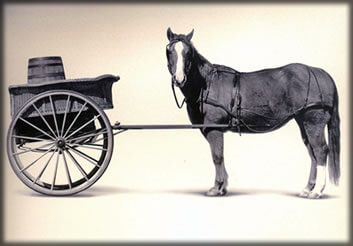Every now and then, at a first production meeting, I hear something that reminds me of this:
I’m sure you’ve heard it too: “Let’s get (or build) a revolve.” “We have a cart we used last year.” “We have that staircase from [name a show].” “We can use periaktoi.” And similar comments.
Granted these ideas are all intended to be helpful, but it’s so easy to home in on one of them and let a piece of scenery drive the set design. I’ve mentioned this one before: a couple of years ago I was at a first meeting for Les Miz at a large community theater, and of course the barricade came up right away. Someone immediately suggested borrowing a 12′ revolve from another company, and several heads nodded in agreement. At which point I brought up two things: one, a 12′ barricade on a 40′ wide stage would not have looked very impressive, and, two, we didn’t need a revolve just because the barricade turns around. So they looked at me and asked what I would do instead, to which I replied “I don’t know yet; this is our first meeting and I haven’t started on the design.” Not what they wanted to hear at that moment, but it had to be my answer.
In the end, they had a much more impressive barricade that turned just fine, and they didn’t have to deal with a revolve. You can read about here, at The barricade in Les Miz.
It’s fine to keep stock pieces in mind, and they can certainly help with the budget or the schedule. However, it’s so much better — in terms of the audience experience — to create a solid, compelling design first, thinking about the story and the characters, and then (and only then) look for stock pieces that fit into the design. A staircase, for instance, built for one show may not work for another show due to size, style, or some other consideration. Ditto for doors, windows, and lots of other items, and the same holds true for furniture and accessories.
By the same token, popular and frequently built scenery pieces — like periaktoi — are not always the best solution to a design problem. What I’ve seen happen often (too often) is that these items become a construction project that drives everything else. You can end up deciding to build three or four periaktoi right up front, before considering the overall set, and then find yourself painted into a corner: “Okay we have them, now what do we do with them?”
If you want to consider periaktoi as problem-solvers (which they are), and not as short-cuts to designing a set (which they are not), you may want to check out my post on them, at Periaktoi: an ancient solution that still works.
Take your time. Study the script, the characters, the period, and all those other things that make up the story, and come up with a physical environment that supports it in the most creative, theatrical manner possible. Then feel free to see what pieces you have that fit in perfectly or that can be modified.
I love that photo above, BTW. It’s like the horse is breaking the fourth wall to ask us, “What’s wrong with this picture?”

